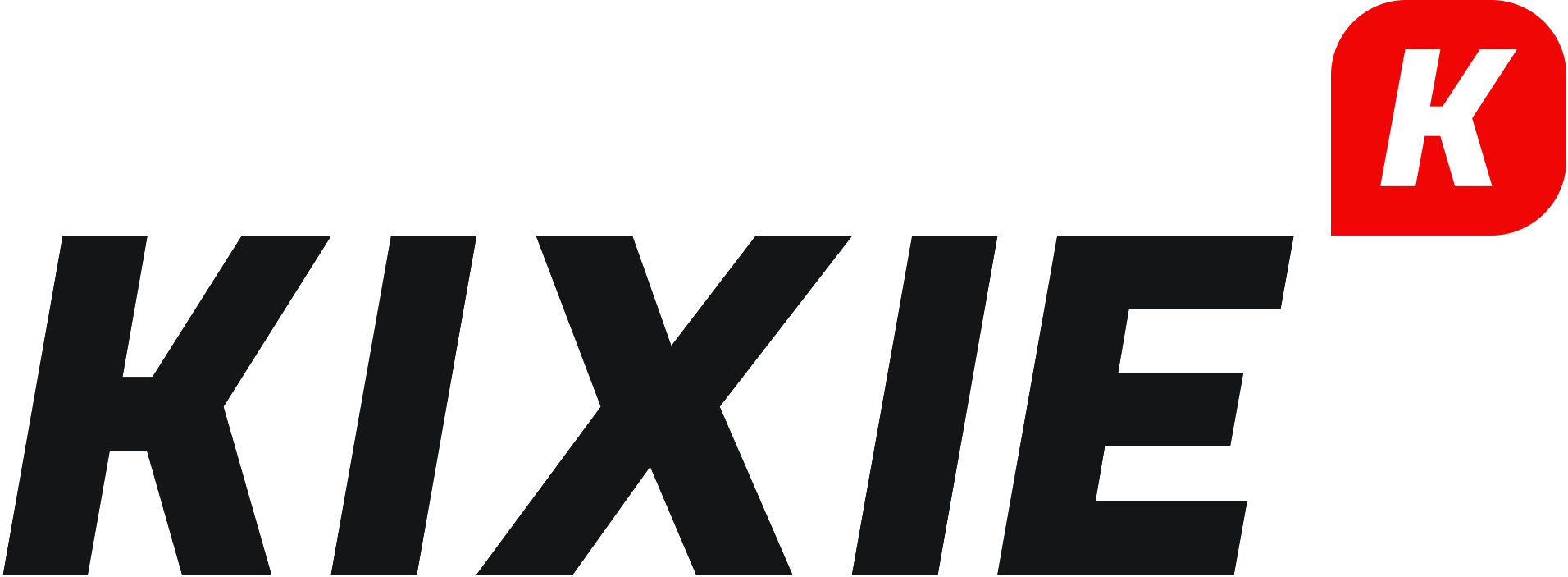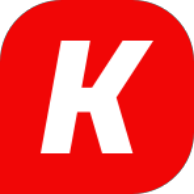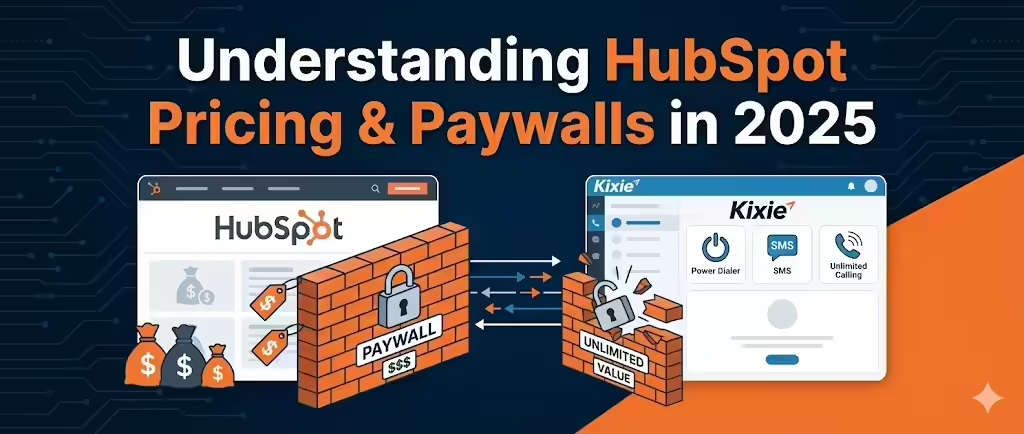TL;DR: HubSpot vs. Kixie Feature and Pricing Analysis
This analysis details HubSpot's 2025 pricing paywalls, comparing HubSpot Sales Hub (Starter, Professional, Enterprise) with the Kixie integration. HubSpot's native platform has mandatory onboarding fees ($1,500 for Pro, $3,500 for Enterprise), restrictive pooled calling minute caps (500 for Starter, 2,000 for Pro, 3,000 for Enterprise), and requires purchasing the separate Marketing Hub Professional ($890/mo) plus an add-on just for automated SMS. Native HubSpot also lacks a multi-line power dialer, native local presence dialing, 1-click voicemail drop, and a shared team SMS inbox. Kixie integrates with HubSpot to provide these missing features, offering unlimited calling, a 10-line power dialer, AI-powered local presence (ConnectionBoost), voicemail drop, and integrated team SMS. Kixie features a bi-directional integration that logs native HubSpot activities and uses call dispositions to trigger HubSpot workflows. A 5-person team upgrading natively in HubSpot (Sales Hub Pro + Marketing Hub Pro) costs $1,390/month plus a $1,500 fee, while the same team using Kixie with HubSpot Starter costs ~$550/month for superior functionality.
Table of Contents
- TL;DR: HubSpot vs. Kixie Feature and Pricing Analysis
- Deconstructing the 2025 HubSpot Sales Hub Model
- HubSpot's "Pay-to-Play" Barrier: Mandatory Onboarding Fees as Pricing Paywalls
- The Multi-Hub Silo: How HubSpot's "All-in-One" Model Creates Compounding Pricing Paywalls
- Critical HubSpot Paywall 1: The Outbound Calling Minute Ceiling and its Impact
- Critical HubSpot Paywall 2: The Native Dialer Functionality Gap
- HubSpot's "Connection Rate" Gap vs. Kixie's Local Presence
- Critical HubSpot Paywall 3: The Disjointed SMS & Automation Structure
- The Integrated Solution: Augmenting HubSpot with Kixie
- Technical Details: Kixie's Bi-Directional HubSpot Integration
- Concluding Analysis: A HubSpot Pricing vs. Kixie Cost-Benefit Framework
The 2025 HubSpot Sales Platform: An Analytical Overview of the "All-in-One" Cost Structure
HubSpot's 2025 platform is engineered as a comprehensive, all-in-one "Customer Platform". This structure is intentionally federated, comprising specialized "Hubs" (including Sales, Marketing, Service, Content, Data, and Commerce) all designed to operate from the central Smart CRM. While this model promises unparalleled data unity, for organizations researching solutions, it is critical to first deconstruct the cost and feature structure.
This analysis reveals a complex, multi-layered pricing model where true costs are obscured behind per-seat fees, mandatory onboarding, and inter-hub dependencies that function as strategic paywalls.
Deconstructing the 2025 HubSpot Sales Hub Model
The financial analysis of HubSpot's sales platform begins with the Sales Hub, which is offered in tiered, per-seat-per-month (PSPM) subscriptions.
The 2025 pricing structure is as follows:
- Sales Hub Starter: Begins at approximately $15-$20/month per seat.
- Sales Hub Professional: Begins at $100/month per seat.
- Sales Hub Enterprise: Begins at $150/month per seat.
This per-seat model represents the first layer of cost, creating a linear and predictable increase in subscription fees as a sales team scales.
However, accessing the platform's advanced functionality is not merely a matter of paying this per-seat fee.
HubSpot's model requires that users in the Professional and Enterprise tiers be provisioned with a specific, higher-cost "Sales Seat" to access the full feature set. While this seems straightforward, the most significant financial barriers are not the recurring seat licenses but the feature gates and substantial one-time fees required to access them.
HubSpot's "Pay-to-Play" Barrier: Mandatory Onboarding Fees as Pricing Paywalls
A significant financial paywall is erected before an organization can even begin using HubSpot's advanced tiers.
Accessing the Professional or Enterprise levels of any Hub, including Sales Hub, requires the payment of a substantial, one-time, mandatory onboarding fee.
- Sales Hub Professional: Requires a $1,500 one-time onboarding fee.
- Sales Hub Enterprise: Requires a $3,500 one-time onboarding fee.
This fee is not a simple "setup" charge; it functions as a strategic "commitment paywall."
For example, Sales Hub Professional is priced at $100/seat per month. For a growing five-person sales team, the decision to upgrade is not just a $500/month commitment ($100/seat x 5).
Because the Professional tier also requires the $1,500 one-time onboarding fee, it is actually a $6,500 first-year commitment ($6,000 in seats + $1,500 fee), with $1,500 being a non-recoupable, sunk cost.
This financial friction intentionally forces a major upfront investment justification.
This is particularly punitive because core, expected sales automation features (such as "sales sequences" for preset outreach) are gated behind this very Professional paywall. In contrast, many integrated solutions are designed for seamless, 3-minute setup specifically without such a "pay-to-play" barrier.
The Multi-Hub Silo: How HubSpot's "All-in-One" Model Creates Compounding Pricing Paywalls
The primary "trap" of the 2025 HubSpot model lies in its multi-hub structure.
While marketed as a unified "Customer Platform", essential sales functions are strategically siloed into other, separately-priced Hubs.
This "cross-departmental" paywall is the most significant and often unexpected barrier for sales teams.
The most acute example is automated SMS messaging. A Sales Operations leader running a team on Sales Hub Professional (which starts at $100/seat) who wishes to implement automated text follow-ups (a core, modern sales task) will find they cannot simply "add SMS" to their existing subscription.
The process to enable this single function is as follows:
- First, the organization must subscribe to Marketing Hub Professional or Enterprise.
- The starting price for Marketing Hub Professional is $890/month.
- After purchasing this separate, high-capacity Hub, the organization must then purchase the "Marketing SMS Add-on".
This model is brilliantly punitive. It forces the sales department to purchase an $890/month marketing automation suite, likely from a different budget, just to enable one basic sales function.
This multi-hub dependency, which reappears in reporting, automation, and communications, is the central financial paywall of the entire HubSpot ecosystem.
Critical HubSpot Paywall 1: The Outbound Calling Minute Ceiling and its Impact
For any sales team engaged in high-velocity outbound prospecting, the most immediate and debilitating bottleneck in the native HubSpot Sales Hub is the hard-coded "productivity cap" on calling.
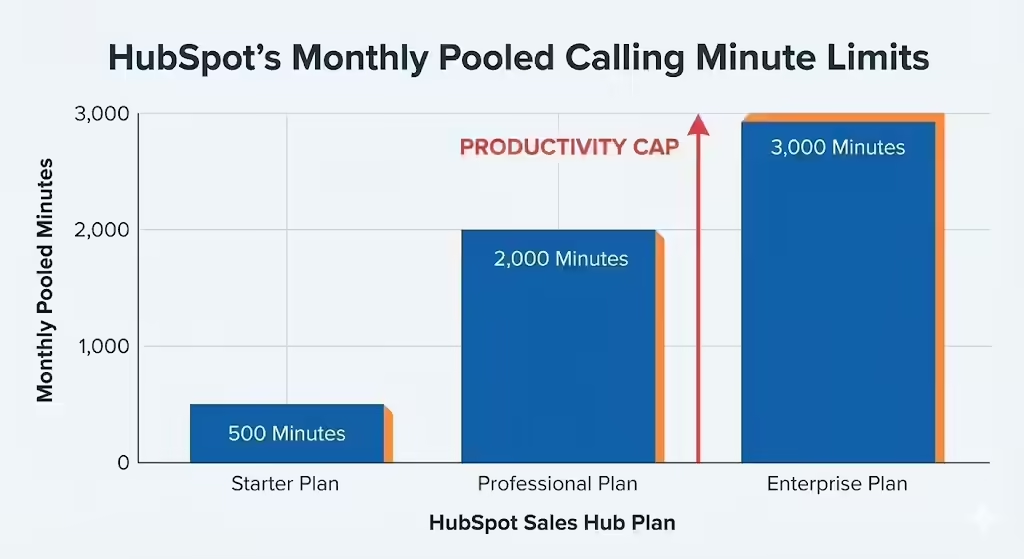
Quantifying HubSpot's Native Calling Limits
HubSpot's native VoIP calling feature includes strict, pooled monthly minute allocations that are shared across the entire sales team.
- Sales Hub Starter Plan: 500 minutes/month.
- Sales Hub Professional Plan: 2,000 minutes/month.
- Sales Hub Enterprise Plan: 3,000 minutes/month.
Operational Impact: The "Productivity Cap" Analysis
Translating these monthly allocations into daily, operational reality reveals their inadequacy.
- On Starter (500 mins), a team shares ~16 minutes of talk time per day.
- On Professional (2,000 mins), a team shares ~66 minutes of talk time per day. For a small team of five sales reps, this allows for less than 14 minutes of talk time per rep, per day.
- On Enterprise (3,000 mins), the entire team is capped at ~100 minutes per day.
This model is operationally crippling for any serious sales team.
Compounding this limitation, all outbound calls are rounded up to the nearest minute. When these pooled minutes are exhausted, a team must either stop all outbound calling for the remainder of the month or purchase costly "additional minute bundles".
Furthermore, this "rounded minute penalty" means that the high-velocity activity of prospecting is actively punished.
A rep making 100 dials to a new list, 80 of which are 15-second voicemails or "wrong number" hang-ups, will burn 80 minutes (80 calls x 1 rounded minute) on non-conversations alone.
These are not functional "calling plans." They are productivity caps designed to throttle outbound activity and force overage payments.
While some marketing materials suggest these limits apply only to outbound calls, HubSpot's own Knowledge Base documentation states, "Minutes are counted for both inbound and outbound calls". This ambiguity presents a significant risk for teams, who may find their pool depleted by both sales and service activities.
In contrast, specialized, integrated calling platforms are built to provide unlimited US/Canada calling, fundamentally removing this ceiling.
Critical HubSpot Paywall 2: The Native Dialer Functionality Gap
Beyond the hard-coded minute caps discussed previously, a more profound functional paywall exists: HubSpot's native platform lacks the core, high-efficiency dialing tools required by modern sales teams.
This is a gap in functionality that no tier of HubSpot Sales Hub (not even Enterprise) can fill.
The "Dialer" Discrepancy: Click-to-Call vs. Power Dialing
HubSpot's marketing lists "VoIP Software" and a "Call Logging App" as features. In practice, this amounts to a simple, single-line click-to-call dialer. This system still requires the sales rep to:
- Manually click to initiate every call.
- Listen to the full ring-cycle.
- Wait for the voicemail beep.
- Manually leave a voicemail.
- Log the call outcome and move to the next record.
This manual process is a massive, time-consuming administrative burden. What HubSpot lacks at any price point is a multi-line power dialer, a feature that is explicitly "not" included in HubSpot Pro or Enterprise.
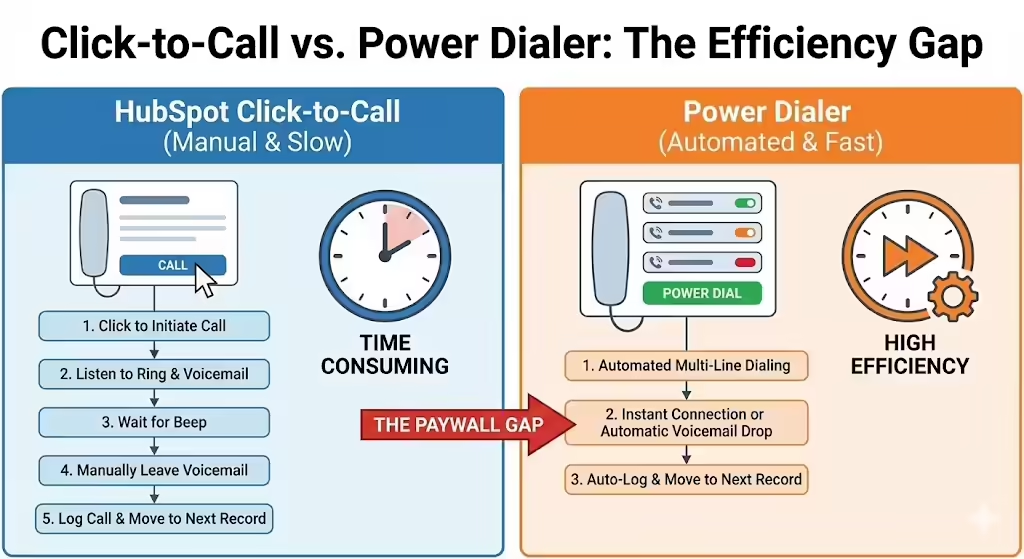
This creates a 10x activity delta. A sales rep using HubSpot's native click-to-call may struggle to make 50-70 dials in a day.
An integrated solution like Kixie provides a Multi-Line PowerDialer that can dial up to 10 numbers simultaneously. This system uses AI-powered machine detection to automatically skip IVRs and voicemails, connecting the rep only when a live human answers the phone. This allows a rep to have 10x more conversations by eliminating the "busywork" between calls.
Furthermore, HubSpot lacks another crucial efficiency tool: 1-Click Voicemail Drop. Integrated platforms allow reps to pre-record a voicemail and "drop" it with a single click the moment they hear a beep, saving hours of repetitive work per week.
HubSpot's "Connection Rate" Gap vs. Kixie's Local Presence
Another significant functional gap in HubSpot's native dialer is its failure to address the single greatest challenge in outbound sales: call connection rates.
Prospects are conditioned to ignore calls from out-of-state area codes or "Spam Risk" numbers. The industry-standard solution is Local Presence Dialing, which automatically matches the rep's outgoing caller ID to the prospect's local area code, dramatically increasing answer rates.
HubSpot does not have a native local presence feature. This is "Another feature HubSpot lacks".
This creates a "spam mitigation gap." Integrated solutions like Kixie's ConnectionBoost not only provide this "AI-powered local presence", they solve the deeper problem of caller ID reputation.
As carriers flag numbers for spam due to high call volume, Kixie's "progressive caller ID" automatically rotates through a pool of real, local numbers for every area code. This "Caller ID Reputation" management prevents any single number from being blacklisted.
HubSpot's native dialer offers no such protection. This means that not only is it 10x slower than a power dialer, but its ability to even connect a call is fundamentally compromised, resulting in a dramatically lower connection rate.
Critical HubSpot Paywall 3: The Disjointed SMS & Automation Structure
The final, and perhaps most complex, paywall is HubSpot's convoluted and cost-prohibitive approach to sales-based SMS and automation.
The Prohibitive Cost of Native HubSpot SMS
Enabling automated SMS in HubSpot is not a simple add-on for the Sales Hub.
It is a multi-step, financially-prohibitive process:
- Mandatory Hub Purchase: The organization must first subscribe to Marketing Hub Professional (starting at $890/month) or Marketing Hub Enterprise (starting at $3,600/month).
- Mandatory Add-on Purchase: After buying the entire Marketing Hub, the organization must also purchase the "Marketing SMS Add-on".
- Usage-Based Limits: The organization is then subject to "message segment" limits, where a single text message (e.g., one over 160 characters or containing an emoji) can consume multiple "segments".
This pricing structure reveals a critical disconnect. HubSpot's platform is engineered to view SMS as a top-of-funnel marketing broadcast tool (hence its placement in the Marketing Hub), not a bottom-of-funnel sales conversation tool.
This model is antithetical to the high-touch, 1-to-1 conversational needs of a sales team.
No Team Inbox, No Unified Workflow
Even if an organization pays the high costs for native HubSpot SMS (which requires buying the separate Marketing Hub and a specific SMS add-on), the native HubSpot tool is functionally incomplete for a sales team.
The platform's calling and texting features are "disconnected," preventing a unified workflow.
The most significant functional failure is the lack of a native "Team SMS" or shared SMS inbox. In the HubSpot model, when a prospect sends a text, it goes only to the individual rep's line.
If that rep is on a call, on vacation, or misses the text, that high-intent inbound lead is lost.
Integrated solutions provide Team SMS (a collaborative, shared inbox) out-of-the-box, allowing any available rep to see and respond to incoming leads.
Most importantly, Kixie unifies the call and text workflows.
A rep can "Send automated followup text messages simply by dispositioning a call in your Kixie dialer". This ability to trigger an "Auto-SMS from call outcomes" creates a seamless, multi-channel follow-up cadence that is structurally impossible to achieve within the native HubSpot platform.
The Integrated Solution: Augmenting HubSpot with Kixie
While HubSpot is a powerful CRM, its 2025 platform, when used alone, fails to provide the tools for high-velocity sales communication.
The native platform, for example, is throttled by low, pooled calling minute caps and is missing critical "enterprise-level tools" such as multi-line power dialers and local presence dialing.
The solution is not to abandon the HubSpot CRM. The solution is to integrate a specialized sales engagement platform that is "built to... improve how your CRM works" and plugs directly into the HubSpot ecosystem. The following table provides a direct, 1-to-1 mapping of HubSpot's functional gaps to the solutions provided by an integrated platform like Kixie.
HubSpot Sales Hub 2025 vs. Kixie Integration: Key Outbound Feature Comparison
| Feature | HubSpot Native (Sales Hub Professional / Enterprise) | HubSpot + Kixie Integration |
|---|---|---|
| Outbound Calling Limits (US/Canada) | "Pooled (2,000-3,000 mins/mo)" | Unlimited |
| Dialing System | Single-Line Click-to-Call | 10-Line Multi-Line PowerDialer |
| Local Presence Dialing | Not Natively Available | Yes (ConnectionBoost™ AI-Powered Local Presence) |
| 1-Click Voicemail Drop | Not Natively Available | Yes |
| Integrated Team SMS Inbox | Not Natively Available | Yes (Native Team SMS) |
| Automated SMS (from Call Outcome) | Not Natively Available; Requires Marketing Hub + Add-on | Yes (Kixie Automations) |
| "Live Call Coaching (Listen, Whisper, Barge)" | Not Natively Available | Yes |
Technical Details: Kixie's Bi-Directional HubSpot Integration
For a Sales Operations or RevOps "researcher" persona, the primary concern with any third-party integration is data integrity and workflow compatibility.
A solution is only viable if it maintains HubSpot as the "single source of truth."
Maintaining a Single Source of Truth: Native Data Logging
A deep, bi-directional integration is designed to enhance, not replace, HubSpot's data model. Kixie achieves this through "native data logging," which is critical for reporting and data integrity.
- Native Logging: All Kixie activities are logged as native HubSpot activities.
- Calls are logged as "native HubSpot calls." Text messages are logged as "native HubSpot SMS".
- Complete Data Sync: This sync includes all call recordings (hosted in Kixie's unlimited cloud storage), call outcomes, and rep notes.
- Object & Association Sync: When a call or text occurs with an unknown number, Kixie automatically creates a new HubSpot contact. All activities are then synced not only to the Contact record, but also to the associated Company and all associated Deals.
This native logging provides a crucial technical advantage: a native integration with HubSpot's Conversation Intelligence (CI) feature. Because Kixie logs as a native call, all Kixie call recordings are "automatically transcribed and analyzed" inside HubSpot's own CI tool. This maintains a single, unified "brain" for all call analytics and coaching, rather than forcing managers to use a separate, disjointed analytics platform.
The Bi-Directional Workflow: "Signal to Action" Automation
The most advanced component of the Kixie integration lies in its "bi-directional" connection with HubSpot Workflows, which Kixie claims is the "most advanced HubSpot Workflows integration of any calling & texting platform".
This connection creates a "closed-loop" automation engine:
- HubSpot -> Kixie (Action to Signal): A HubSpot Workflow (e.g., "New Lead" or "Deal Stage Change") can be configured to trigger a Kixie AutoDial or AutoSMS action. This allows for instant, automated "speed to lead" engagement.
- Kixie -> HubSpot (Signal to Action): This is the more powerful, enterprise-grade connection.
- A call disposition logged by a rep in the Kixie dialer (e.g., "Not Interested," "Left Voicemail") can "trigger any HubSpot Workflow".
This "Signal to Action" capability is what truly eliminates administrative work and ensures 100% process compliance. A sales rep can finish a call, select "Left Voicemail" in the Kixie dialer, and this one-click "Signal" instantly triggers a HubSpot Workflow ("Action") that might:
- Send a pre-written follow-up email.
- Send an automated Kixie follow-up text ("Sorry I missed you...").
- Enroll the contact in a "Voicemail" sequence.
- Create a new follow-up task for the rep in two days.
This "closed-loop" automation connects the human sales action (the call disposition) directly to the CRM's automation brain, turning the entire sales engagement layer into a seamless, automated process.
Concluding Analysis: A HubSpot Pricing vs. Kixie Cost-Benefit Framework
For the HubSpot-based sales organization in 2025, hitting a communication or automation wall presents two distinct and dramatically different upgrade paths.
A. Defining the Two Upgrade Paths
Path 1: The "HubSpot Native" Upgrade Path
A 5-person sales team on Sales Hub Starter (approx. $15/seat) needs sales automation (sequences).
- Step 1: They must upgrade to Sales Hub Professional.
- Cost: $100/seat/mo ($500/mo) + $1,500 one-time onboarding.
- Result: They now have sequences but are immediately throttled by a 2,000-minute pooled calling cap and still have no power dialer, local presence, or 1-click voicemail drop.
- Step 2: The team now needs automated SMS to follow up on their sequence calls.
- They must also purchase Marketing Hub Professional.
- Cost: $890/month (for the Hub) + the cost of the SMS Add-on.
Final Tally (Path 1): This 5-person team is now paying $1,390/month ($500 for Sales Hub Pro + $890 for Marketing Hub Pro) plus a $1,500 entry fee, all for a functionally inferior system that still has hard calling caps, no power dialer, and a disjointed SMS tool.
Path 2: The "Integrated Specialist" Path (with Kixie)
The same 5-person team on HubSpot Sales Hub Starter (approx. $15/seat) needs sales automation and better calling.
- Step 1: They add an integrated, specialized sales engagement platform.
- Cost: e.g., Kixie's Outbound Powerdialer plan at $95/seat/mo.
- Final Tally (Path 2): This 5-person team is paying a total of ~$550/month.
- Result: For less than half the monthly cost and zero onboarding fees, this team receives unlimited calling, a 10-line multi-line power dialer, AI-powered local presence, 1-click voicemail drop, and fully integrated team SMS with advanced automation. All of this data is logged natively back into their HubSpot Starter CRM.
B. Final Recommendation
The analysis of HubSpot's 2025 pricing model indicates that upgrading within the native HubSpot ecosystem to solve for high-velocity sales communication is financially prohibitive and functionally incomplete.
The platform's structure is built on strategic paywalls, such as hard-coded, pooled minute caps that throttle activity and multi-hub dependencies that require expensive, separate Hub purchases for basic features like SMS.
For the analytical Sales Operations leader or "researcher," the most logical, scalable, and cost-effective solution is to use HubSpot as the central CRM (its core strength) while integrating a specialized, best-in-class platform like Kixie to manage the entire sales engagement layer.
This "Integrated Specialist" model provides functionality that exceeds HubSpot's native Enterprise tier for a cost that is often less than its Professional tier, all while eliminating the financial and functional "paywalls" central to HubSpot's 2025 platform.
